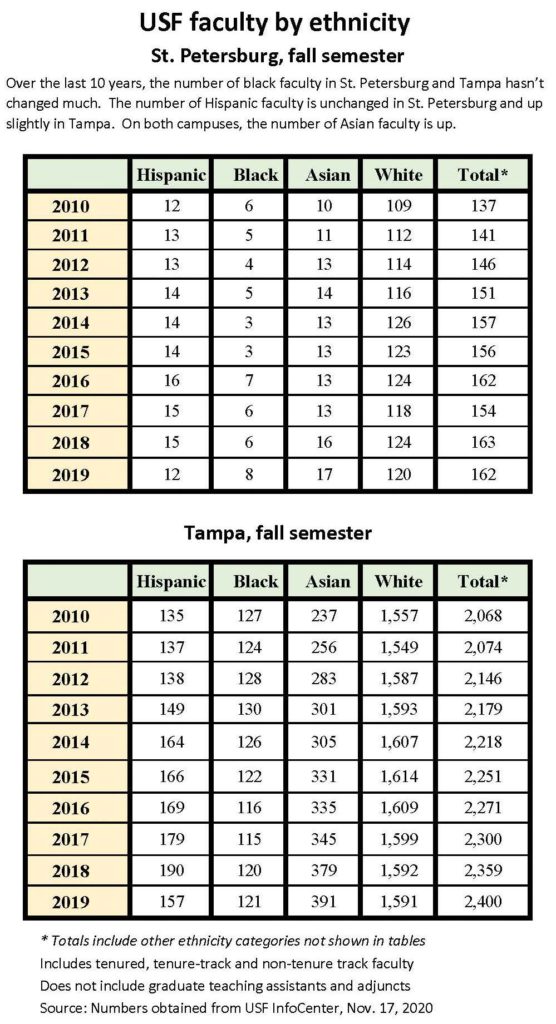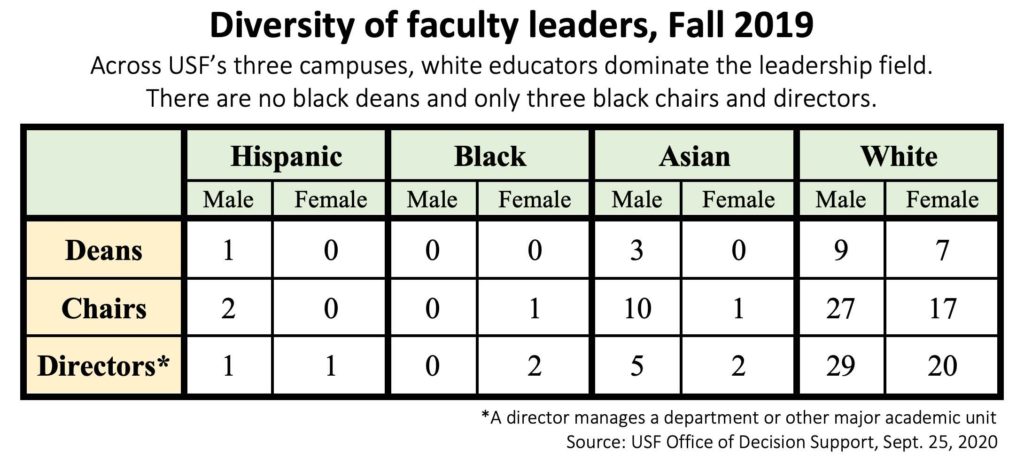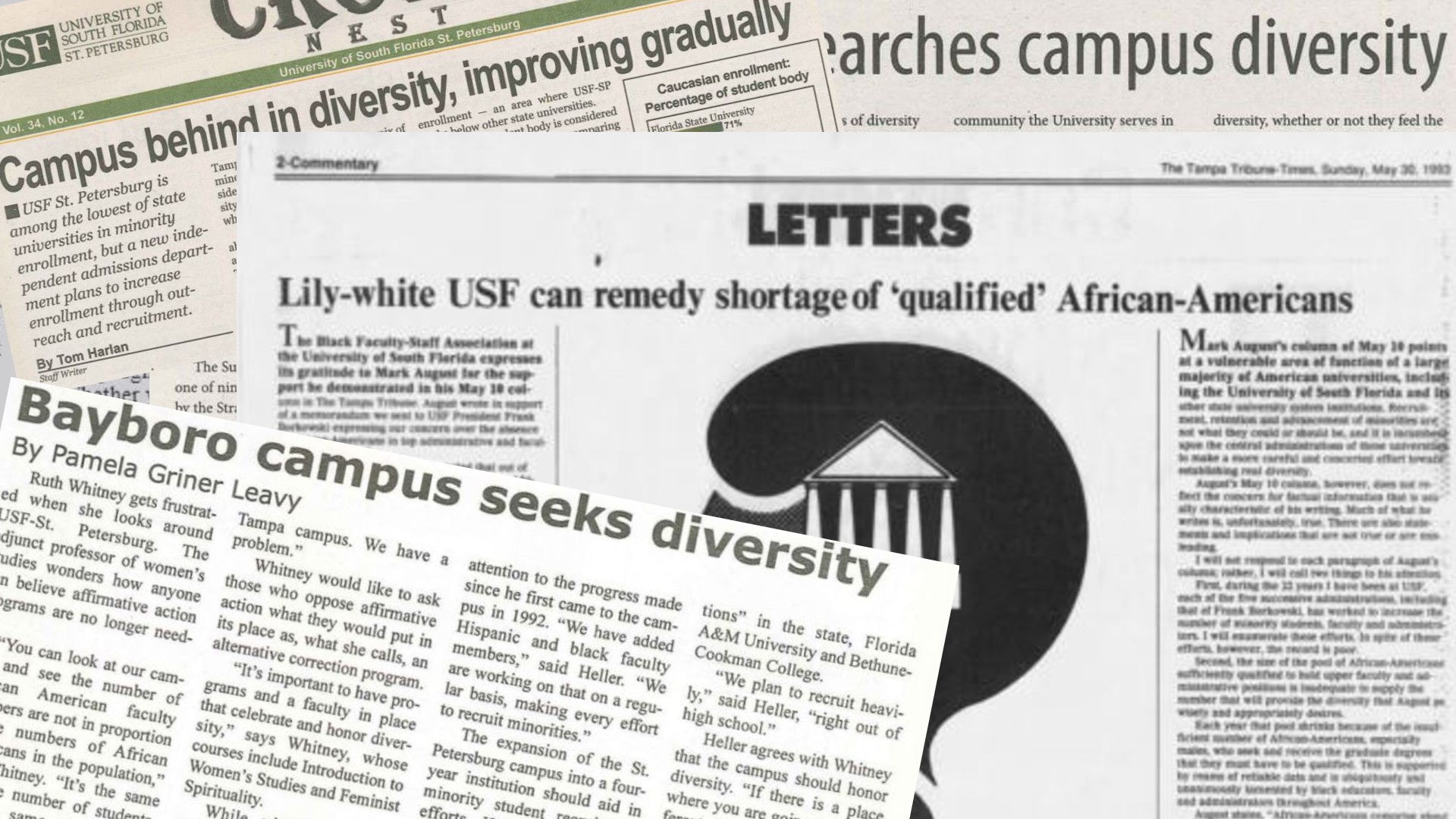Pictured Above: Headlines from years past show that the lack of faculty diversity is a longstanding issue.
Sophie Ojdanic | The Crow’s Nest
By Nancy McCann and Janel S. Cooper
Twenty-seven years ago, the Black Faculty-Staff Association at USF lamented the dearth of black educators in faculty and administrative positions.
Only 55 of the 1,336 full-time faculty members (4.1 percent) were black, the association said in a memo to the administration, and none of the university’s 71 department chairs were black.
“If USF is to emerge as a mature institution sensitive to its place as a major urban research university, and if it seeks to ‘look more like America’ by the 21st century,” it needs to step up the recruiting and promotion of black educators, association president Wanda Lewis-Campbell said in a letter to the Tampa Tribune.
Things haven’t changed much since then.
In the fall of 2019, only eight (4.9 percent) of the 162 faculty members in St. Petersburg and 121 (5 percent) of the 2,400 faculty members in Tampa were black.
And over the last decade, the numbers of black faculty were essentially unchanged (see charts)

In St. Petersburg over the last 10 years, the number of Hispanic faculty (12) was also unchanged, and the number of Asian faculty was up (10 in 2010 and 17 in 2019).
In Tampa, the number of Hispanic faculty has grown from 135 to 157 and the number of Asian faculty from 237 to 391.
That means about two-thirds of the faculty on the two campuses is white.
The ranks of faculty leadership are overwhelmingly white as well.
In 2019, there were no black deans and only three black department chairs and directors in St. Petersburg, Tampa and Sarasota-Manatee (see chart)

In a presentation to a USF Board of Trustees committee in August, Cecil Howard, the university’s assistant vice president for diversity, displayed statistics comparing the diversity picture to numbers at other state universities.
USF’s statistics are “not the worst numbers around,” Howard said. “But I definitely don’t want to rest on our laurels.”
Regional Chancellor Martin Tadlock has a less positive view.
USF’s performance on faculty diversity in recent years has “not been a giant step forward,” he told The Crow’s Nest. The numbers “don’t reflect the diversity of the community where we sit.”
Pinellas County has a black population of about 11 percent and St. Petersburg, about 23 percent.
Michelle Madden, St. Petersburg’s campus diversity officer, said the current faculty diversity numbers aren’t a surprise to her.
“I have been looking at these numbers for the last couple years. It is not anything that I think anybody thinks is acceptable,” she said. “I can’t say when I first saw the actual numbers that I was shocked because walking through campus . . . you can see that there is a lack of racial diversity on our campus.
“I don’t think these numbers are where anybody wants them to be. This is an issue not only on our campus but in higher education overall. Many cite a big disparity between their white faculty and faculty of color.”
Although the university’s faculty diversity picture has not improved much since the Black Faculty-Staff Association addressed the issue in 1993, it has gotten a lot of attention in recent months.
In June, shortly after the death of George Floyd prompted a national resurgence in the Black Lives Matter movement, 88 black faculty and staff members at USF sent a call to action to President Steve Currall.
In their letter, they said that “targeted anti-racist policies, procedures and an adequate grievance process must be established (or improved) to effectively address systemic racism.”
They called for mandatory sensitivity training for administrators, increased racial and ethnic diversity in both leadership and faculty positions, the creation of racial accountability protocols in the faculty tenure and promotion process, an evaluation of salary disparities and increased funding in Africana and Latin American studies.
In a statement that same week, Currall and Haywood Brown, USF’s vice president for institutional equity, said USF would “redouble efforts to be a force of positive change.”
Those efforts will include professional development of faculty and staff and “helping to ensure that hiring practices for administrators and faculty are free from bias and reflect USF’s commitment to diversity,” the statement said.
Two months later, Currall issued a detailed update on steps the university is taking.
Those steps include the investment of $500,000 in research projects that address the concept, origin and consequences of systemic racism, an increase in black student outreach and strengthening relationships between USF and the black community.
Currall also announced that Brown had been appointed to the university’s 11-member Executive Leadership Council and that Elizabeth Hordge-Freeman – a sociology professor who drafted the June letter signed by black faculty and staff – had been appointed a senior adviser to Currall and the provost on diversity and inclusion.
In September, Currall’s efforts were jolted when all six members of a diversity committee at the College of Arts and Sciences resigned in a stinging rebuke of the administration.
The diversity committee “is disappointed that the voice representing the largest college in the university is being silenced, ignored or ‘mediated,’ ” the members said.
“Our effort to engage with the USF administration at multiple levels has ultimately led to a reassertion of an academic hierarchy that reinforces, rather than reduces, the ‘hush culture’ at USF,” the letter said.
But Brown says things are being done to improve faculty diversity. .
“The university has a commitment to casting a wide net for recruitment and retention of a diverse faculty, especially black faculty,” Brown wrote in an email to The Crow’s Nest last month.
A news website that focuses on inequality in education — The Hechinger Report — warns that improving faculty diversity is a difficult task.
“Many predominantly white four-year public and nonprofit colleges and universities that have been promising for years to improve the diversity of their teaching ranks have made almost no progress in doing so,” according to a 2018 article on a widespread decline in hiring black faculty.
That’s certainly been the case at USF St. Petersburg.
Twenty-one years ago, The Crow’s Nest published a story about the lack of diversity in the St. Petersburg faculty. Comments made by Ruth Whitney, then an adjunct instructor in women’s studies, sound familiar today.
“You can look at our campus and see the number of African American faculty members are not in proportion to the numbers of African Americans in the population,” Whitney said. “It’s the same with the number of students. It’s the same case on the Tampa campus. We have a problem.”
Patrick Tobin contributed to this report.



